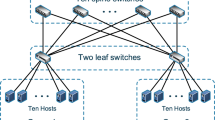Abstract
In this work we study a routing scheme combined with an end-to-end rerouting procedure. We focus in particular on a new rerouting strategy called Shared Robust Rerouting (ShRR). This strategy combines three other restoration techniques, namely path diversity, end-to-end rerouting with stub release and global rerouting, in order to achieve cost-effectiveness. Computational results on the bandwidth overhead required by the proposed scheme are provided, as well as a comparison with some conventional restoration schemes.















Similar content being viewed by others
Notes
At this point our method is similar to the demand-wise shared protection strategy.
References
Gunnar, A., & Johansson, M. (2011). Robust load balancing under traffic uncertainty—tractable models and efficient algorithms. Telecommunications Systems, 48(1), 93–107.
Hock, D., Hartmann, M., Menth, M., Pióro, M., Tomaszewski, A., & Zukowski, C. (2011). Comparison of IP-based and explicit paths for one-to-one fast reroute in MPLS networks. Telecommunications Systems. doi:10.1007/s11235-011-9603-4.
Karp, R. M. (1975). On the complexity of combinatorial problems. Networks, 5, 45–68.
Koster, A. M., Zymolka, A., Jager, M., & Hulsermann, R. (2005). Demand-wise shared protection for meshed optical networks. Journal of Network and Systems Management, 13(1), 35–55.
Lutton, J.-L., Nace, D., & Carlier, J. (2000). Assigning spare capacities. In Mesh survivable networks telecommunication systems (Vol. 13, pp. 441–451).
Maurras, J.-F., & Vanier, S. (2004). Network synthesis under survivability constraints, 4OR. Quarterly Journal of Belgian, French, and Italian Operations Research Societies, 2(1), 53–67.
Mereu, A., Cherubini, D., Fanni, A., & Frangioni, A. (2009). Primary and backup paths optimal design for traffic engineering. In Hybrid IGP/MPLS networks 7th international workshop on Design of Reliable Communication Networks 2009, DRCN.
Nace, D., Pióro, M., Tomaszewski, A., & Żotkiewicz, M. (2011). A polynomial multicommodity flow problem with difficult path generation. In 3rd international Congress on ultra modern telecommunications and control systems and workshops (ICUMT), Budapest, 5–7 October 2011.
Orlowski, S. (2003). Local and global restoration of node and link failures in telecommunication networks. Diploma thesis, Konrad–Zuse–Zentrum für Informationstechnik, Berlin (ZIB).
Orlowski, S., & Pióro, M. (2012). On the complexity of column generation in network design with path-based survivability mechanisms. Networks: an International Journal, 59(1), 132–147.
Pickavet, M., Demeester, P., & Vasseur, J.Ph. (2004). Network recovery. San Mateo: Morgan Kaufmann.
Robertson, N., & Seymour, P. D. (1995). Graph minors. The disjoint paths problem. Journal of Combinatorial Theory. Series B, 63(1), 65–110.
SNDLIB: http://sndlib.zib.de.
Suurballe, J. W. (1974). Disjoint paths in a network. Networks, 4, 125–145.
Wessaly, R., Orlowski, S., Zymolka, A., Koster, A. M., & Gruber, C. (2005). Demand-wise shared protection revisited: a new model for survivable network design. In Proceedings of International Network Optimization Conference (INOC), Lisbon (pp. 100–105).
Acknowledgements
The authors wish to thank Yoann Fouquet for his help in achieving the experimental part of this study.
Author information
Authors and Affiliations
Corresponding author
Rights and permissions
About this article
Cite this article
Fundo, A., Bashllari, A., Nace, D. et al. A hybrid rerouting scheme. Telecommun Syst 56, 69–78 (2014). https://doi.org/10.1007/s11235-013-9819-6
Published:
Issue Date:
DOI: https://doi.org/10.1007/s11235-013-9819-6




